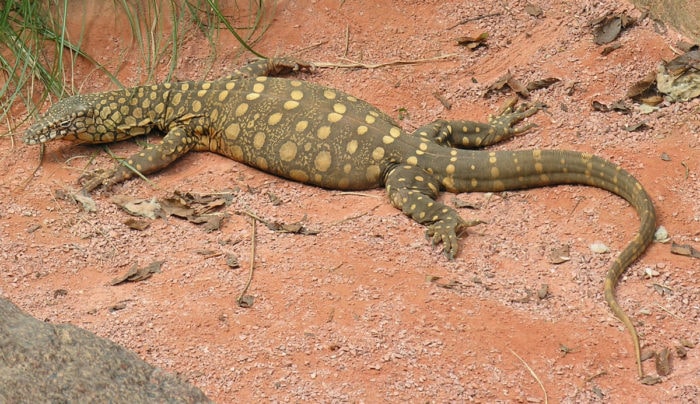This gigantic monitor is proof that Australia has the best reptiles

Bec Crew
Bec Crew

Back in 2015, the world’s smallest monitor was discovered in the Dampier Peninsula of Western Australia, weighing in at just 16 grams. And at the other end of the scale, our largest monitor is the mighty perentie (Varanus giganteus) – a legendary goanna that can match the speed of an Olympic sprinter.
At 2.5 metres long and up to 20 kg, the perentie weighs the same as a standard poodle, and while it’s not the largest monitor in the world, what it lacks (relatively) in bulk, it makes up for in style.
As the fourth largest species of lizard on Earth (after the Komodo dragon, the Asian water monitor, and the crocodile monitor), the perentie is found in the arid desert areas of Western Australia, South Australia, the Northern Territory, and Queensland.
The incredible patterns that adorn its thick, leathery skin are said to have inspired a particular style of Aboriginal woodcarving, and legend has it their origins are tied to the arguably more beautiful black-headed monitor (Varanus tristis).

The black-headed monitor. (Image credit: Kristian Bell/Shutterstock)
American herpetologist and evolutionary ecologist, Dr Eric Rodger, recalls the story from the Pitjantjatjara people of Central Australia of how the perentie and the black-headed monitor gave each other their spots:
“Welding the brush first, the perentie decorated its cousin handsomely. Then came the smaller monitor’s turn. It started off well, the brush creating a netlike pattern from the perentie’s snout to midsection, but then, frustrated by how long the job was taking, the artist picked up the paint and dumped it over the perentie’s hindquarters.
According to legend, the perentie continues to seek revenge, and its cousin lives an arboreal [tree-based] life for fear of retribution.”
You can kind of see what the story’s referring to below, but let’s be honest – it’s still a pretty decent paint job:

(Image credit: Greg Goebel/Wikimedia)
Apart from its distinctive patterning, which is said to be so unique from lizard to lizard, it can be used to identify individuals like fingerprints, perenties can run at speeds of up to 40 km/h, and they can stand up on their hind legs and ‘tripod’ to get a better view of their surroundings.
And unlike most lizards, they have a forked tongue like a snake, and they just might wield a venomous bite, but that’s still up for debate.
With so many cool traits, it’s no wonder the perentie got the David Attenborough treatment:
And let’s not forget this iconic take from Steve Irwin:
We might all be experiencing a case of the Mondays right now, but it can’t be worse than having an overly enthusiastic admirer pursuing you into your den and asking, “Are you upset?”

